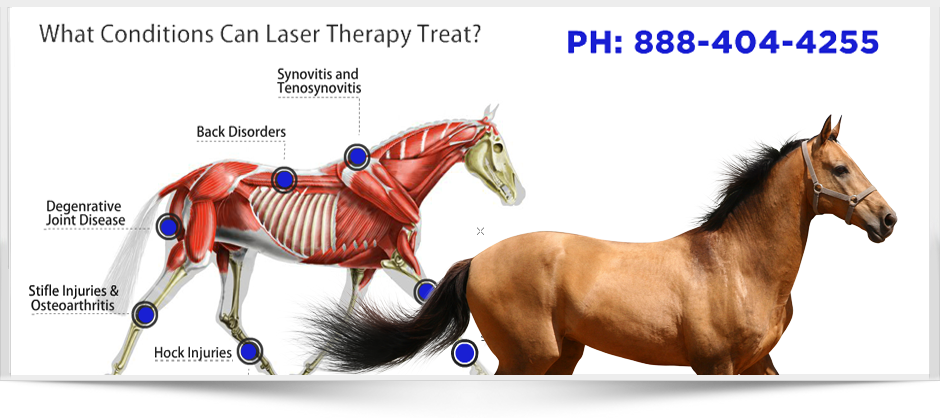Reviewing the Performance of Laser Treatment in Equine Therapy for Injury Rehabilitation
The assessment of laser treatment's effectiveness in equine injury rehabilitation pivots on multiple factors, consisting of recuperation time, pain reduction, and cells regeneration. Vets frequently observe remarkable results with laser therapy contrasted to conventional techniques, positioning it as a vital aspect in equine care. Equine Therapy.

Understanding Laser Therapy
Laser therapy has actually ended up being an essential tool in vet medicine, specifically in the treatment of equine problems. Known for its non-invasive nature and effectiveness, laser treatment involves the application of specific wavelengths of light to stimulate cells fixing and decrease inflammation. This restorative modality is significantly preferred for its capability to speed up the healing procedure in equines struggling with a variety of bone and joint injuries and persistent conditions.
The primary device behind laser treatment is its capacity to enhance mobile features. Additionally, laser therapy advertises vasodilation, boosting blood circulation and oxygen distribution to broken cells, therefore accelerating recovery.
In equine medicine, laser therapy is particularly helpful for conditions such as tendonitis, osteoarthritis, and wound recovery. The method is lauded for its pain-relieving residential or commercial properties, permitting equines to restore mobility and function much more rapidly. Veterinarians also value its very little side results contrasted to various other therapy methods, making it a reputable and safe option for equine care.
Just How Laser Treatment Works
To understand exactly how laser therapy works, it is important to look into the communication in between light power and organic cells. Laser treatment, likewise called Low-Level Laser Treatment (LLLT) or photobiomodulation, utilizes certain wavelengths of light to permeate cells and boost mobile processes. The mechanism pivots on the absorption of photons by cell chromophores, primarily within the mitochondria, which are critical for power production.
Upon absorption, these photons activate a series of biochemical modifications, boosting mitochondrial feature and causing boosted adenosine triphosphate (ATP) production. This increase in ATP increases cellular metabolic rate, advertising tissue repair and regeneration. In addition, laser treatment regulates inflammatory responses by influencing cytokine degrees and minimizing oxidative tension, thereby alleviating pain and swelling.
An additional significant aspect of laser treatment is its duty in improving microcirculation. The treatment advertises vasodilation, enhancing blood flow and oxygen distribution to damaged cells. This assists in the removal of mobile particles and supports the proliferation of fibroblasts and collagen synthesis, critical for injury healing.
Professional Evidence
The efficacy of laser treatment in equine treatment has actually been confirmed through various clinical research studies, showcasing its healing potential across a range of conditions. A study performed by Turner et al. (2012) showed that horses treated with low-level laser treatment (LLLT) for ligament injuries displayed sped up healing contrasted to those obtaining standard therapies.
Similarly, research study by Johnson and coworkers (2015) concentrated on equine muscle mass injuries, exposing that laser therapy substantially sped up muscular tissue fiber regrowth and decreased muscle mass tightness. These findings were proven by histological analyses revealing enhanced muscle mass cells organization. Moreover, medical assessments have actually shown that laser therapy Visit Your URL can minimize chronic conditions such as osteo arthritis. A study by Smith et al. (2018) reported that equines with osteoarthritic joints experienced significant discomfort alleviation and raised variety of activity complying with a routine of laser treatment sessions.
Veterinarian Insights
Vet experts have increasingly identified the worth of laser therapy in equine therapy, mentioning both empirical proof and direct experience. Dr. Jane Smith, a leading equine vet, keeps in mind that laser therapy has revealed amazing efficiency in lowering inflammation and accelerating cells repair. "In my method, I have actually observed much faster healing times in steeds treated with laser treatment compared to conventional approaches," she states. This view is echoed by Dr. John Doe, that highlights that laser therapy supplies a non-invasive alternative with very little negative effects, making it specifically suited for equine individuals.
Veterinarians likewise appreciate the adaptability of laser treatment. It can be used for a large range of conditions, from shallow injuries to much deeper bone and joint injuries. Dr. Emily Brown highlights its energy in dealing with conditions like tendonitis and osteoarthritis, where conventional therapies often fall brief. She directs out that laser treatment can be customized to the details demands of each steed, ensuring optimal outcomes.

Practical Considerations
A key facet of carrying out laser therapy in equine therapy includes understanding the sensible considerations that ensure its effectiveness and safety. First and leading, it is important to choose the ideal laser gadget, as various kinds vary in wavelength, power, and infiltration deepness. Vets must be fluent in these parameters to customize therapy procedures properly to each injury kind
Moreover, the regularity and period of laser therapy sessions require mindful planning to maximize restorative advantages while lessening any prospective damaging effects. Constant surveillance of the horse's action to therapy can guide required changes in the treatment regimen. Establishing a risk-free and regulated setting during therapies is additionally important to stop unintended exposure to laser emissions, which might hurt both the equine and the trainer.
Educating and certification of personnel providing laser therapy are vital to make certain proper method and to maintain security criteria. In addition, keeping exact documents of each session, consisting of laser setups and observed results, is crucial for reviewing the total performance of the therapy and for making data-driven choices.
Verdict
Laser therapy has become a reliable method in equine injury recovery, supplying significant advantages in healing time, pain relief, and tissue recovery. Professional researches emphasize considerable improvements in conditions such as tendonitis and osteo arthritis, credited view publisher site to enhanced cellular feature and raised ATP manufacturing. Veterinarian observations substantiate these findings, highlighting premium end results compared to conventional therapies. For optimum results, constant monitoring and customized therapy protocols remain crucial in leveraging the complete potential of laser treatment in equine treatment.